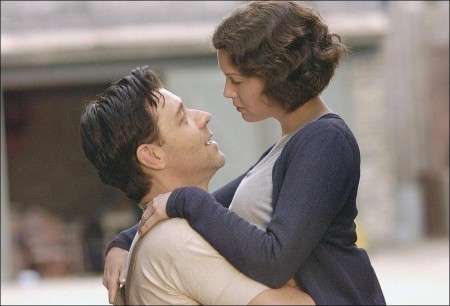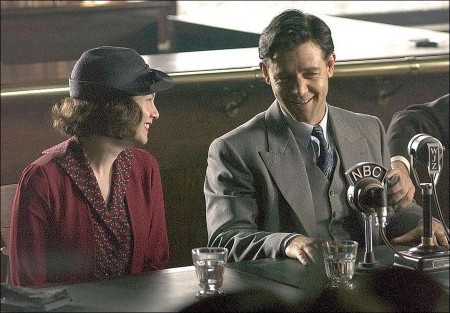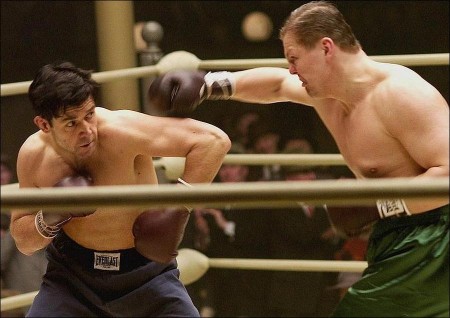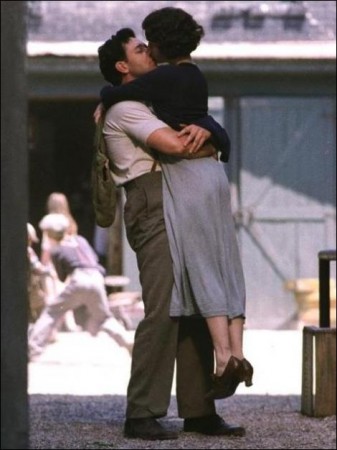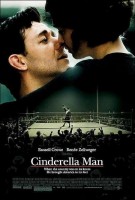“In all the history of the boxing game, you’ll find no human interest story to compare with the life narrative of James J. Braddock.” – Damon Runyon (1936)
In the middle of the Great Depression, when an America in the grips of a devastating economic downturn was nearly brought to its knees, there came along a most unlikely hero who had crowds cheering on their feet-as he proved just how hard a man would fight to win a second chance for his family and himself.
That common-man hero was James J. Braddock-a.k.a. the “Cinderella Man”-who was to become one of the most surprising and inspirational sports legends in history. By the early 1930s, the impoverished ex-prizefighter was seemingly as broken-down, beaten-up and out-of-luck as much of the rest of the American populace. Like so many others, Braddock had hit rock bottom.
His career appeared to be finished, he was unable to pay the bills, the only thing that really mattered to him-his family-was in danger, and he was even forced to go on Public Relief. But deep inside, Jim Braddock never relinquished his determination. Driven by love, honor and an incredible dose of grit, he willed an impossible dream to come true. In a last-chance bid to help his family, Braddock returned to the ring. No one thought he had a shot. In bout after bout, the talk was that poor Jim Braddock was criminally out-matched and perilously in over his head.
Except that Braddock, fueled by something beyond mere competition, kept winning. Suddenly, the ordinary working man who couldn’t get a job became the mythic athlete who could not lose. Carrying the hopes and dreams of the disenfranchised on his shoulders, Braddock rocketed through the ranks, until this underdog who defied all the odds chose to do the unthinkable: take on the heavyweight champ of the world, the unstoppable Max Baer, renowned for having killed two men in the ring.
With Cinderella Man, an Academy Award-winning team-comprised of producer Brian Grazer, director Ron Howard, screenwriter Akiva Goldsman and actors Russell Crowe and Renée Zellweger-comes together to tell the quintessentially American story of a man who was not so much a great boxer as a great man who boxed his way out of darkness and defeat and into the stuff of immortality.
Academy Award winner Russell Crowe stars as Jim Braddock, whose single-minded devotion to family and dignity became just as famous as his tricky feints and killer left hook. The story begins when Braddock-once full of promise-is forced into retirement from boxing after a run of bad luck, just as America itself is sliding into the most frightening hard economic times the nation has ever known. Facing imminent poverty, Jim wants only to do right by the woman who has always been his source of strength-his feisty wife Mae, played by Oscar winner Renée Zellweger. At first, he takes a string of dead-end dock jobs that only seem to leave him poorer. But soon, the tightly-wedded couple are drowning in debt and emotionally devastated to see their children shivering in an unheated apartment amid the dead of a Jersey winter.
Then, as a result of the efforts of Jim’s indefatigable manager, Joe Gould (played by Golden Globe nominee Paul Giamatti), Jim gets an out-of-the-blue, last-ditch shot to fight in Madison Square Garden-and more importantly, a chance to put some food on the table for those he loves. Despite being too old, too hungry and too injured to be considered a real contender-and in direct opposition to Mae’s strident fears for her husband’s life-Braddock nevertheless steps back into the ring without any training. Stunning the crowd and the media, he knocks out his rising-star opponent…thanks in part to a powerful hook developed during countless hours of dock work. But it doesn’t stop there. His career re-ignited, he starts to dig his family, victory by victory, out of their hole. And the more he wins, the more Jim Braddock unwittingly becomes a folk hero, until it is as if every time he stands up to an opponent, he is standing up for the millions just like him battling to take care of their families and keep alive their sidelined dreams.
Then, finally, comes the match of Braddock’s life, as he boldly agrees to face off against world heavyweight champ Max Baer, a cocky powerhouse of a fighter with a punch so lethal he has already killed two men in the ring. Some say that Braddock will never even survive the match. Indeed, the odds are ten to one in Baer’s favor as Braddock steps into his corner. But Jim Braddock has a different view: that this time he knows in his heart the incredible stakes for which he is fighting.
Says director Ron Howard: “The story of Jim Braddock continues to be so incredibly stirring because it is a tale that reminds us of just how remarkable human endurance and the power of love can be. Cinderella Man is a true American story about what it’s like to cope in the moment, facing life’s daily hardships, and to continue to passionately strive toward a goal-even a simple one like putting food on the table-no matter what the outcome turns out to be. It’s that kind of story that has always intrigued me as a filmmaker.”
Who Is James J. Braddock?
In the middle of the Great Depression, when an America in the grips of a devastating economic downturn was nearly brought to its knees, there came along a most unlikely hero who had crowds cheering on their feet-as he proved just how hard a man would fight to win a second chance for his family and himself.
That common-man hero was James J. Braddock-a.k.a. the “Cinderella Man”-who was to become one of the most surprising and inspirational sports legends in history. By the early 1930s, the impoverished ex-prizefighter was seemingly as broken-down, beaten-up and out-of-luck as much of the rest of the American populace. Like so many others, Braddock had hit rock bottom. His career appeared to be finished, he was unable to pay the bills, the only thing that really mattered to him-his family-was in danger, and he was even forced to go on Public Relief. But deep inside, Jim Braddock never relinquished his determination. Driven by love, honor and an incredible dose of grit, he willed an impossible dream to come true.
In a last-chance bid to help his family, Braddock returned to the ring. No one thought he had a shot. In bout after bout, the talk was that poor Jim Braddock was criminally out-matched and perilously in over his head. Except that Braddock, fueled by something beyond mere competition, kept winning. Suddenly, the ordinary working man who couldn’t get a job became the mythic athlete who could not lose. Carrying the hopes and dreams of the disenfranchised on his shoulders, Braddock rocketed through the ranks, until this underdog who defied all the odds chose to do the unthinkable: take on the heavyweight champ of the world, the unstoppable Max Baer, renowned for having killed two men in the ring.
Academy Award winner Russell Crowe stars as Jim Braddock, whose single-minded devotion to family and dignity became just as famous as his tricky feints and killer left hook. The story begins when Braddock-once full of promise-is forced into retirement from boxing after a run of bad luck, just as America itself is sliding into the most frightening hard economic times the nation has ever known. Facing imminent poverty, Jim wants only to do right by the woman who has always been his source of strength-his feisty wife Mae, played by Oscar winner Renée Zellweger. At first, he takes a string of dead-end dock jobs that only seem to leave him poorer. But soon, the tightly-wedded couple are drowning in debt and emotionally devastated to see their children shivering in an unheated apartment amid the dead of a Jersey winter.
Then, as a result of the efforts of Jim’s indefatigable manager, Joe Gould (played by Golden Globe nominee PAUL GIAMATTI), Jim gets an out-of-the-blue, last-ditch shot to fight in Madison Square Garden-and more importantly, a chance to put some food on the table for those he loves. Despite being too old, too hungry and too injured to be considered a real contender-and in direct opposition to Mae’s strident fears for her husband’s life-Braddock nevertheless steps back into the ring without any training. Stunning the crowd and the media, he knocks out his rising-star opponent… thanks in part to a powerful hook developed during countless hours of dock work. But it doesn’t stop there. His career re-ignited, he starts to dig his family, victory by victory, out of their hole.
And the more he wins, the more Jim Braddock unwittingly becomes a folk hero, until it is as if every time he stands up to an opponent, he is standing up for the millions just like him battling to take care of their families and keep alive their sidelined dreams. Then, finally, comes the match of Braddock’s life, as he boldly agrees to face off against world heavyweight champ Max Baer, a cocky powerhouse of a fighter with a punch so lethal he has already killed two men in the ring. Some say that Braddock will never even survive the match. Indeed, the odds are ten to one in Baer’s favor as Braddock steps into his corner. But Jim Braddock has a different view: that this time he knows in his heart the incredible stakes for which he is fighting.
Says director Ron Howard: “The story of Jim Braddock continues to be so incredibly stirring because it is a tale that reminds us of just how remarkable human endurance and the power of love can be. Cinderella Man is a true American story about what it’s like to cope in the moment, facing life’s daily hardships, and to continue to passionately strive toward a goal-even a simple one like putting food on the table-no matter what the outcome turns out to be. It’s that kind of story, that kind of cinematic journey that has always intrigued me as a filmmaker.”
The Cinderella Story of James Braddock
The Jazz Age of the 1920s was a golden time for America, as the nation celebrated peace and booming prosperity on the heels of World War I. It was also a Golden Era for boxing, the brutal yet beautifully balletic sport that had captured the public imagination with its raw, primal struggles for transcendence in the ring. In the melting pot society of the early 20th century, disparate immigrant groups drew pride from their “native” sons who boxed; communities with strong Old World roots found a focus, an expression of their heritage, each time a fighter wearing their national colors or symbol climbed into the ring.
It was during this era that James J. Braddock, a New Jersey-based amateur known for his fierce right hand, turned pro. Like many working-class kids, Braddock saw boxing as his ticket to a decent life. It was the only thing he was ever good at-and for a while he was very, very good.
His career shone with promise in the early years, when he was dubbed “the Bulldog of Bergen” for an unflinching tenacity that seemed to carry him through fights with far larger opponents. But, after sustaining irreparable damage to his badly broken right hand, his career began to slide downhill. In 1929, he suffered a crushing defeat at the hands of light heavyweight champ Tommy Loughran, who beat him in a heartrending 15-round decision that touched off a seemingly endless string of bad luck and ugly losses. Braddock was never the same again.
Nor was the nation. That same year, the stock market crashed, wiping out 40 percent of the paper values of common stock. As the shockwave spread, American families from all walks of life and every economic class lost their savings, their businesses, their homes and their farms. By 1932, nearly one in four Americans was unemployed.
The nation was reeling in shock, as throngs of once working families began showing up at Salvation Army shelters. Food lines, work lines and Public Relief lines-something many Americans never thought they would see in their own country-became a commonplace sight. The poorest of the poor were forced to live in “Hoovervilles,” grim cardboard-shack shantytowns that sprang up on the edges of most major cities (named with bitter irony for U.S. President Herbert Hoover, who, prior to losing the 1932 election to Franklin Delano Roosevelt, had failed to put into place any federal aid programs for struggling families). Thousands upon thousands of others roamed the country, searching for any job no matter how hard, demeaning or dangerous. For the first time since the nation’s pilgrim beginnings, many Americans faced the real and haunting prospect of hunger and malnutrition. Suicide rates among men who had lost their jobs soared.
Like so many bankers, butchers, farmers and factory workers, Jim Braddock watched as his life, too, began to fall apart. When the local boxing commission forced him to retire by revoking his license, Braddock searched valiantly for any available jobs, but there weren’t many. He took hard-labor jobs in the shipyards, hauling sacks, or anything else he could get. Yet he was making so little that at one point, Braddock was trying to feed a family of five on just $24 a month. It seemed like a losing battle. When the family could no longer afford the basics-milk, gas, electricity-Braddock applied for Relief. It was a terrible blow to his pride, a secret shame that many who had always worked for their families were experiencing across the country.
But then in 1934, just as Roosevelt’s New Deal began to kick into high gear, Braddock’s luck began to shift as well. Unexpectedly, he was given the chance to fight John “Corn” Griffin in a bout Braddock was, by all accounts, pretty much guaranteed to lose. Instead, he managed to dance and jab his way to a win no one could quite believe-thanks in part to a newly strengthened left hand as a result of his stints working on the docks. Shortly after that, as if to prove it wasn’t a fluke, he won a 10-round decision against Hall of Fame light heavyweight John Henry Lewis. Then, he took on Art Lasky, who had won all but one of his last 15 fights-yet Braddock dispatched him too in a thrilling 15-rounder.
With these remarkable wins, Braddock’s spirit became renewed. Remarkably, one of the first things he did with his earnings was to pay back his Public Relief debt to the government. This selfless act of honor earned Braddock a new moniker among his growing ranks of American fans: “Gentleman Jim.” Suddenly, with his fame beyond the boxing world increasing every day, he found himself in the unlikely position of being able to make a title shot against heavyweight champion Max Baer.
It might seem like a chance any boxer would jump at-but Braddock had plenty of reasons not to take the fight. In fact, many in the sports world warned that it was a potentially deadly match-up. Braddock was much smaller than Baer, far less experienced and had to rely mainly on his newfound left hook, favoring his formerly injured right. Baer, on the other hand, had recently been brought up on manslaughter charges when one of his opponents was instantly killed by his powerhouse knockout punch.
Though he was later cleared of the charges, there was little doubt that Baer, when riled up, was one of the most dangerous fighters in the sport. (Baer had also subjected opponent Ernie Schaaf to a knockout punch in the tenth round of their 1932 fight, leaving him unconscious; Schaaf later died following a bout with Primo Carnera and his death was attributed in part to the brutal beating at the hands of Baer.) In 1933, Baer fought one of the greatest matches of all time, knocking out Max Schmeling in a ten-round fight that would go down in history. In 1934, the same night that Jim Braddock fought Corn Griffin, he defeated Primo Carnera, knocking him down 11 times in 11 rounds.
Despite critics’ cries that Braddock-Baer would be an unfair bout and his wife Mae’s concerns that she could lose her husband to a boxing match, Braddock persevered and jumped into some of the most challenging training a boxer had ever undertaken. The build-up to the match only increased the tension, with Max Baer publicly predicting an easy knockout and reportedly taunting Braddock by calling him a “bum”-an insult Braddock definitely could not let pass without an answer.
At last, the Braddock-Baer fight took place on June 13, 1935, in front of a packed crowd of 35,000 fans in Madison Square Garden. Millions more huddled around their radios to hear the blow-by-blow commentary. Baer came on strong in the first few rounds, but Braddock was undeterred-fueled as he was, fighting for his family’s survival. Each time one fighter dominated the round, the crowds anticipated an early end to the fight-yet the opponent invariably rallied back. This nearly impossible to call, give-and-take battle continued for an unbelievable 15 rounds. Braddock, possessed by an unfailing spirit and pounding away with remarkable endurance, lasted all 15…and finally won the fight in a unanimous decision.
Instantly, it was proclaimed the greatest upset in boxing history… if not all of sports. In bars and living rooms around the country, ordinary people celebrated Braddock’s championship as if he were one of their own family. The fight seemed to remind a desperate world that sometimes the down-and-out not only manage to stay alive but, in the process, become the greatest on earth. It was incredibly fitting that sports writer Damon Runyon had dubbed Braddock the “Cinderella Man” because his rags-to-riches story so resembled a classic fairy tale.
Braddock continued to fight, losing the heavyweight title to Joe Louis in 1937 in an eighth-round knockout (Louis was then 23 while Braddock was a comparatively ancient 32-and Louis would later say that Braddock was one of the most courageous fighters he ever fought). He went on to beat the odds one last time, defeating the talented Tommy Farr in 1938, putting him in position to fight for the title again. But instead, he retired, saying to reporters that he was doing so not because he was done fighting but out of fairness to his wife and family.
Over the years, Braddock continued to be a hero to all those who knew his story. He was inducted into the Ring Boxing Hall of Fame in 1964 and International Boxing Hall of Fame in 2001. He served honorably in World War II and went on to own and operate heavy equipment on the same docks where he labored for a pittance during the Depression. In the 1950s, he helped to build Brooklyn’s famous Verrazano Bridge, which was at the time the largest suspension bridge in the world. He died in 1974 at the age of 68.
These production notes provided by Universal Pictures.
Cinderella Man
Starring: Russell Crowe, Renée Zellweger, Connor Price, Craig Bierko, Paul Giamatti
Directed by: Ron Howard
Screenplay by: Cliff Hollingsworth, C. Gaby Mitchell, Akiva Goldsman
Release Date: June 3rd, 2005
MPAA Rating: PG-13 for intense boxing violence and language.
Studio: Universal Pictures
jh4>Box Office Totals
Domestic: $61,649,911 (56.8%)
Foreign: $46,890,000 (43.2%)
Total: $108,539,911 (Worldwide)
